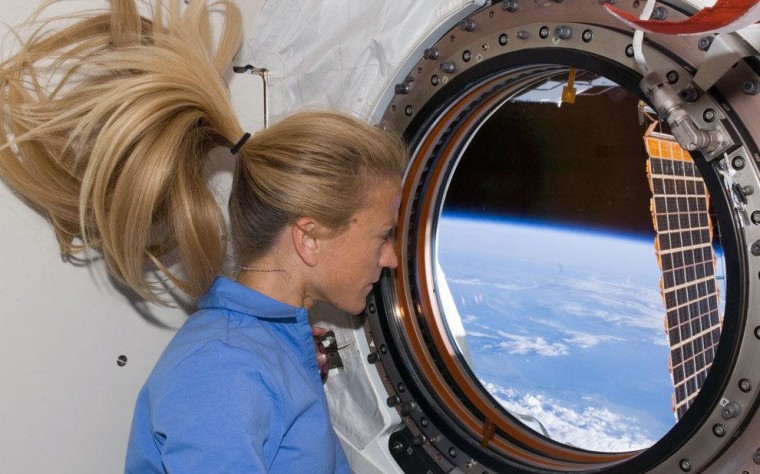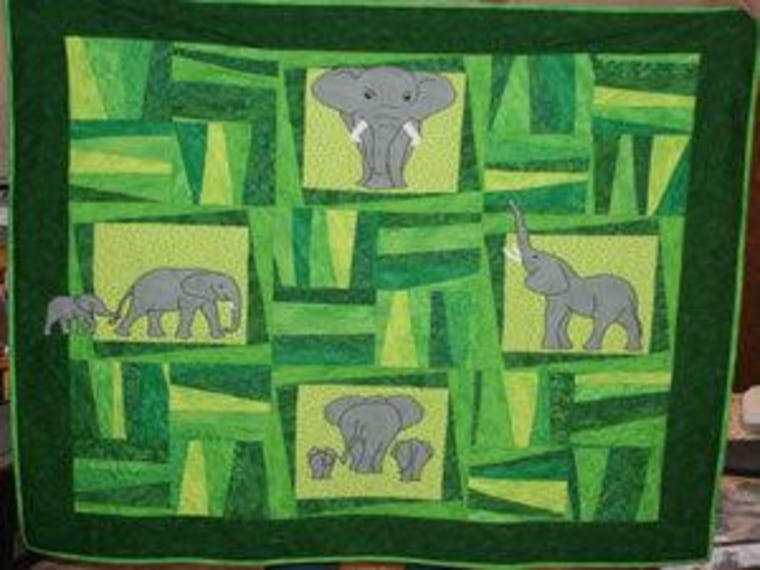
When astronaut Karen Nyberg is launched to the International Space Station, she’ll bring something entirely new to the space frontier: the art of quilting.
"I enjoy sewing and quilting," she explained during a televised interview from Moscow. "I am bringing some fabric with me, and thread. I'm hoping to create something. I don't know what yet it will be — that's part of creativity. It comes with the feeling of the day. So I have the supplies at my hands to create, if I get the opportunity and the creative notion to do so."
When she's launched into space on May 28, she'll be taking four "fat quarters" with her (pieces of fabric that are 18 by 22 inches), along with some needles and thread. But up-cargo limitations and safety issues mean she can't take a sewing machine, an iron, paints, a rotary cutter or other common tools of quilters.
Stitching in zero-G
To do quilting in zero gravity, she'll have to brace herself somewhere so she and her fabrics don't float around, find some good light, and keep her thread and thread clippings under strict control so they don't float into someone's face and eyes.
Precision stitching will surely be a challenge for her too, since she, the fabric, and the thread will want to float free, not sit steady and still. As she explained in a recent tweet, "It will be great experiment controlling everything!"

Though she's limited in the material and equipment she can bring into space, Nyberg can use fabric or patches from the discarded astronaut clothing already on board the space station — some of it quite colorful. As a rule, the space station crew members wear a flight suit for a week and then discard it. There are no laundry facilities aboard the space station, so the uniforms are generally added to the trash heap that builds up inside a Russian Progress resupply ship after it is emptied. Eventually, the Progress is jettisoned, and everything in it burns up in Earth's atmosphere.
The issue of obtaining sewing scraps from a readily available "rag bag" in orbit first came up in a face-to-face interview in Houston last month. She broke into a broad, excited smile: "Discarded clothing — fantastic idea!"
And although paints and dyes are forbidden on the space station, Nyberg pointed out that there are condiments aboard that can take their place, which might be used as decoration — ketchup, mustard and chili sauce can make for some interesting painting materials.
Down to Earth
The first quilt in space would be an exciting, unique and valuable item. Bringing a quilt back to Earth might be a problem, since Nyberg has a limited space allotment in the Soyuz capsule she'll be traveling in next November. But she hopes to bring at least some of her handiwork back with her.
Fortunately, there may be additional opportunities to bring her space handiwork down to Earth. Unmanned SpaceX Dragon cargo capsules are carrying supplies up to the space station, with the next flight scheduled in November. The Dragon has a large volume for returning cargo to Earth, and NASA and SpaceX should be able to find room for a quilt or two.
If Nyberg has access to a cosmic rag bag of discarded uniforms from many countries — the United States, Russia, Canada, Italy, Japan and others — think of what her fellow quilters back on Earth could do with such star-struck materials. NASA could decide to recycle space-flown uniforms back to Earth someday, and distribute them to quilters as part of a citizen outreach project.
The International Space Station itself is already a patchwork quilt of hardware: equipment, life support systems and structural elements that have been fabricated in various nations and pieced together over more than a decade. As with quilting, the station's life support systems emphasize recycling and re-use.
Nyberg has not mentioned any designs for her quilts. She said that she's "counting on creativity when I get there.” She has a sketch pad, a pencil and a pencil sharpener to draw out the ideas that come to her. Whether it follows a traditional design, or a new look dictated by cosmic imagination, whether it's simple or fancy, the first quilt in space will undoubtedly become one of those precious images we’ll have sewn into our culture.
More about space crafts:
NBC News space analyst James Oberg spent 22 years at NASA's Johnson Space Center as a Mission Control operator and an orbital designer. Alcestis Oberg is a science writer and quilt collector. The Obergs are co-authors of "Pioneering Space: Living on the Next Frontier."